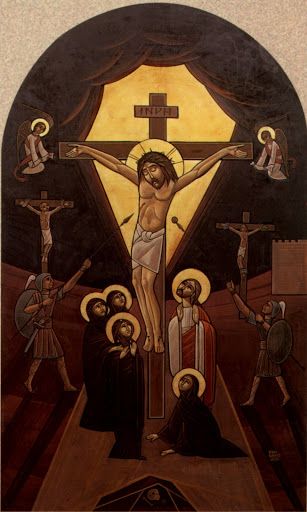Coptic icon
Mount Calvary Church
Eutaw Street and Madison Avenue
Baltimore, Maryland
A Roman Catholic Parish
The Personal Ordinariate of the Chair of St. Peter
Anglican Use
Rev. Albert Scharbach, Pastor
Rt. Rev. Stephen Lopes, Preacher
Good Friday
April 19, 2019
Noon Mass of the Pre-Sanctified
__________________
The Reproaches, Tomás Luis de Victoria
In the Catholic liturgy of Good Friday, the day of Christ’s suffering and crucifixion, the Eucharist is not celebrated. Instead, the service includes a quasi-dramatic recitation of the Passion according to St. John, and a solemn act of veneration of the Cross. The priest unveils the image of the cross, and people may come forth and adore the symbol of the atoning death, while hymns, motets, and “reproaches” are sung by the choir. The music for the “reproaches” is entitled Popule meus, from the text of the first refrain, “My people, what have I done to you, and how have I grieved you? Answer me.” Among the thirty-seven various pieces of Holy Week music published by Tomas Luis de Victoria in 1585 is a simple, but quite effective, setting of these reproaches, or improperia. The liturgical form calls for an alternation between two refrains and a series of versets. The latter, left to be sung in Gregorian plainchant, all follow a poignant parallel structure, calling to mind (in the first person of the Deity) first an act of God’s mercy and providence from the past, and then a present element of the Passion, such as
“Because I led you from the land of Egypt, you have prepared a Cross for your savior.”
and
“I have scourged Egypt with its firstborn for love of you, and you have delivered me to be scourged.”
Interspersed with these versets are two refrains, both of which Victoria sets to fairly simple homophony. The first is the “Popule meus,” again in the first person, as if God Himself is reproaching His people for their acts which led to the Cross. The second, fascinatingly, presents the only survival in the Western liturgy (besides the common Mass text “Kyrie eleison”) of a text in Greek. This ancient relic, the “Trisagion,” a threefold acclamation of the holiness of God, is intended to be sung first in Greek, and then in Latin.
Here it is sung in English at the Church of the Advent in Boston.
___________________________
Crucifixus, Claudio Monteverdi
Crucifixus etiam pro nobis sub Pontio Pilato, passus et sepultus est
Here is the Capella Mariana.
__________________
Hymn
#83 O sorrow deep! (O TRAURIGKEIT) This Good Friday and Holy Saturday lament was printed in eight 5-line verses in Johannes Risten himlischer Lieder. It was entitled ‘Klägliches Grab-Lied/ Uber die trawrige Begräbnisse unseres Seylandes Jesu Christi/ am stillen freytage zu singen’ (‘ A sorrowful funeral hymn on the mournful entombment of our Saviour Jesus Christ, to be sung on Good Friday’). A note was added at the end: ‘The first verse of this funeral hymn, along with its exceptional melody, came accidentally into my hands. As I was greatly pleased with it, I added the other seven as they stand here, because I could not be a party to the use of the other verses.’ This was presumably because of their Roman Catholic content. The first verse referred to was printed in the Roman Catholic Würzburg Gesang-Buch (1628).
O sorrow deep!
Who would not weep
With heartfelt pain and sighing?
God the Father’s only Son
In the tomb is lying.O Jesus blest,
My help and rest,
With tears I pray thee, hear me:
Now, and even unto death,
Dearest Lord, be near me.
Here is the melody.
1 O Traurigkeit,
o Herzeleid!
Ist das nicht zu beklagen?
Gott des Vaters einig Kind,
wird ins Grab getragen.
2 O große Noth!
Gott selbst liegt tot,
am Kreuz ist er gestorben,
hat dadurch das Himmelreich
uns aus Lieb’ erworben.
3 O Menschenkind,
nur deine Sünd’
hat dieses angerichtet,
da du durch die Missetat
warest ganz vernichtet.
4 Dein Bräutigam,
das Gotteslamm,
liegt hier mit Blut beflossen,
welches er ganz mildiglich
hat für dich vergossen.
5 O süßer Mund.
o Glaubensgrund,
wie bist du doch zerschlagen!
Alles, was auf Erden lebt,
muß dich ja beklagen.
6 O lieblich Bild,
schön, zart und mild.
du Söhnlein der Jungfrauen,
niemand kann dein heißes Blut
sonder Reu’ anschauen!
7 O selig ist,
zu jeder Frist,
der dieses recht bedenket,
wie der Herr der Herrlichkeit
wird ins Grab gesenket!
8 O Jesu, du,
mein’ Hilf’ und Ruh’,
ich bitte dich mit Tränen:
Hilf, daß ich mich bis ins Grab
nach dir möge sehnen!
Johann Rist (1608-1667) was born at Ottensen in Holstein-Pinneberg (today Hamburg), the son of the Lutheran pastor of that place, Caspar Rist. He received his early training at the Gelehrtenschule des Johanneums in Hamburg and the Gymnasium Illustre in Bremen; he then studied theology at the University of Rinteln. Under the influence of Josua Stegman there, his interest in hymn writing began. On leaving Rinteln, he tutored the sons of a Hamburg merchant, accompanying them to the University of Rostock, where he himself studied Hebrew, mathematics, and medicine. During his time at Rostock, the Thirty Years War almost emptied the University, and Rist himself lay there for several weeks, suffering from pestilence. In 1650, he became tutor in the house of Landschreiber Heinrich Sager at Heide, in Holstein. Two years later (1635) he was appointed pastor of the village of Wedel on the Elbe. He died in Wedel on 31 August 1667.
The translation in the 1940 Hymnal was done by C.Winifred Douglas (1867-1944), a prodigious translator and a renowned collector of Native American pottery.
____________________________
